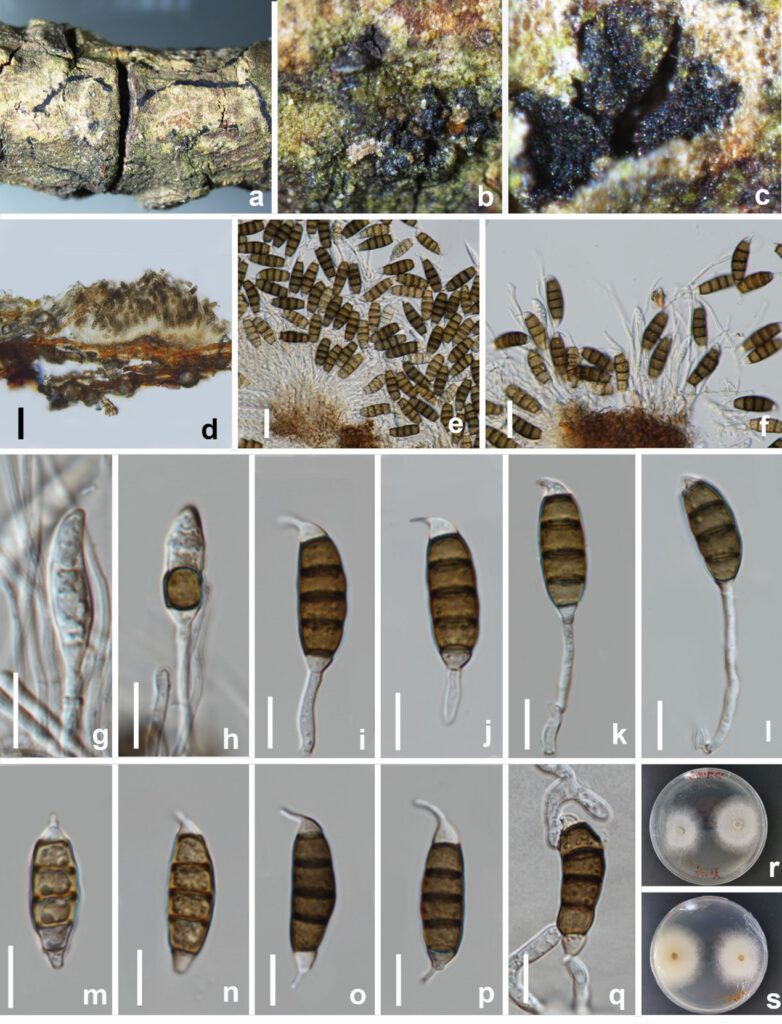Seiridium guangyuanum W.L. Li & Jian K. Liu, in Li, Dissanayake, Zhang, Maharachchikumbura & Liu, Journal of Fungi 8(11, no. 1175): 19 (2022)
Index Fungorum number: IF 845409; MycoBank number: MB 845409; Facesoffungi number: FoF 12749
Etymology – Name reflects the location Guangyuan city where the holotype was collected.
Holotype – HKAS 123219
Pathogenic on diseased branches of Vernicia fordii Hemsl. Sexual morph: Not observed. Asexual morph: Conidiomata 106–108 μm high, 13–20 μm diam. (x̄ = 107 × 12 μm, n = 15), sporodochial, scattered to gregarious, immersed to erumpent from tissue, initially closed and globose to subglobose, later dehiscing by a split in the overlying tissue and then appearing broadly conical in sectional view, unilocular, locule, occasionally convoluted, glabrous black. Conidiomata wall 38–45 μm thick at sides, not well defined, comprising brown, thin-walled cells of textura angularis, with lighter cells at the base fusing into the host tissue. Conidiophores septate, cylindrical, irregularly branched, branch lengths variable (22–42.5 μm long), occasionally reduced to conidiogenous cells, hyaline or paler brown, thin- and smooth-walled. Conidiogenous cells 11.5–16 × 2–2.5 μm (x̄ = 14 × 2 μm, n = 30), discrete, hyaline, cylindrical to subcylindrical with moderate periclinal thickenings in the collarentes zone, smooth- and thin-walled, proliferating percurrently. Conidia 27–30 × 8–9 μm (x̄ = 28.5 × 8.5 μm, n = 30), lunate to falcate, straight or slightly curved, 5-septate, bearing appendages; basal cell obconical with a truncate base, hyaline, smooth-walled, 3–4 μm; four median cells, 20–23, smooth, short cylindrical, thick-walled and smooth, septal pores distinctly visible, yellowish-brown to brown, and septa darker than the rest of the cells, 4 median cells together 20–23 μm long, second cell from base 5–6.5 μm long, third cell 5–6 μm long, fourth cell 4.5–5.5 μm long, fifth cell 4.8–6 μm long; apical cell conical, hyaline, thin-walled, smooth, 2.5–3.5 μm long, apical appendage single, mostly excentric, 2.5–5.5 μm long; basal appendage, when present, single, unbranched, centric, 3–4.5 μm long; mean conidium length/width ratio = 3.5:1.
Culture characteristics – Colonies on PDA reaching 20 mm diam. after 2 weeks at 25 ℃. Colonies from above: dense, aerial mycelium on surface flat or raised, effuse with floccose texture, margin crenate and filamentous, white to cream at the margin, white in the centre, reverse similar in colour.
Materials examined – CHINA, Sichuan Province, Guangyuan city, on a diseased branch of Vernicia fordii, 19 April 2021, W.L. Li, YT 184 (HKAS 123219, holotype), ex-type living culture, CGMCC3.23561; ibid., T. Zhang, YT 44 (HUEST 22.0042, paratype), living culture, UESTCC 22.0041; ibid., W.L. Li, YT200, (HUEST 22.0045, paratype), living culture, UESTCC 22.0044; ibid., W.L. Li, YT237, (HUEST 22.0048, paratype), living culture, UESTCC 22.0047; ibid., W.L. Li, YT243, (HUEST 22.0038, paratype), living culture, UESTCC 22.0037; Jiangyou city, on a diseased branch of Camellia oleifera, 10 June 2021, Z.P. Liu, YC29, (HUEST 22.0047, paratype), living culture, UESTCC 22.0046; ibid., YC 30, (HUEST 22.0046, paratype), living culture, UESTCC 22.0045. Chengdu city, on a diseased branch of Olea europaea, 20 January 2021, Z.P. Liu, GLL 17, (paratype, HUEST 22.0044), living culture, UESTCC 22.0043.
Notes – Eight strains of Seiridium guangyuanum formed a separate lineage in the muti-gene phylogeny as sister to S. ceratosporum (PHSI2001Pathcw07) with high bootstrap support (ML/BI 100%/1). Seiridium guangyuanum is distinct from S. ceratosporum by 12 bp differences in ITS (508 bp, no gap) (Table 3) and 5 bp differences in tub2 (750 bp, no gaps). Morphologically, Seiridium guangyuanum differs from S. ceratosporum by conidial (27–30 μm vs. 29–35 μm) and apical appendage measurements (2.5–5.5 μm vs. 4–8 μm). In addition, their mean conidium length/width ratio is distinct (3.5:1 vs. 2.9:1). Moreover, conidiogenous cells of S. ceratosporum proliferating percurrently multiple times, while proliferations and moderate periclinal thickenings are absent in those of S. guangyuanum.

Figure 5 – Seiridium guangyuanum (HKAS 123219, holotype) a–c Appearance of conidiomata on host substrate. d vertical section of conidiomata. e–f Sporodochia. g–l Conidiophore and conidia. m–p conidia. q Germinating conidium. r, s Upper and reverse view of the colony (on PDA). Scale bars: d = 50 μm, e, f = 20 μm, g–q = 10 μm
